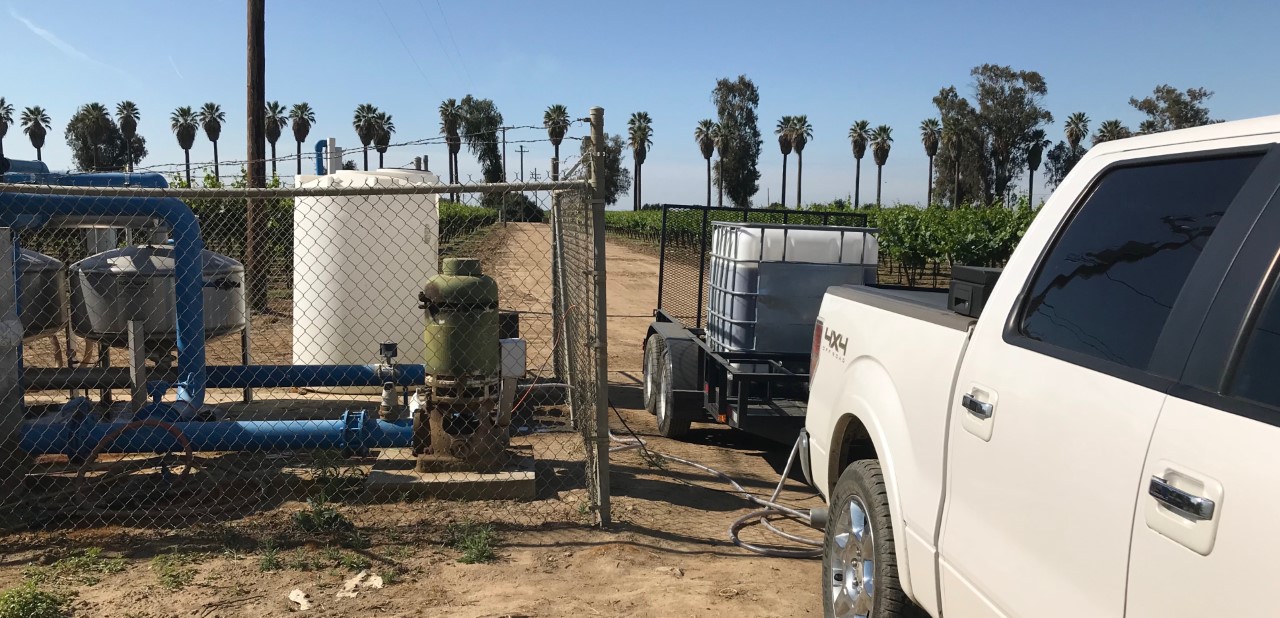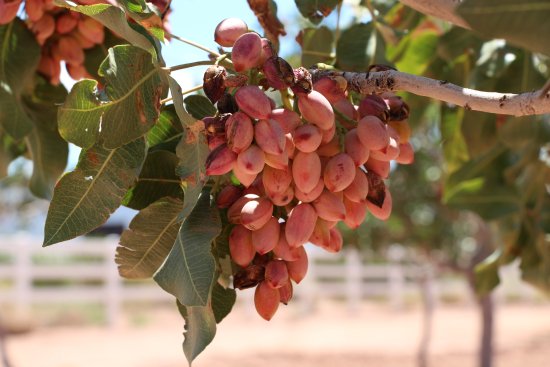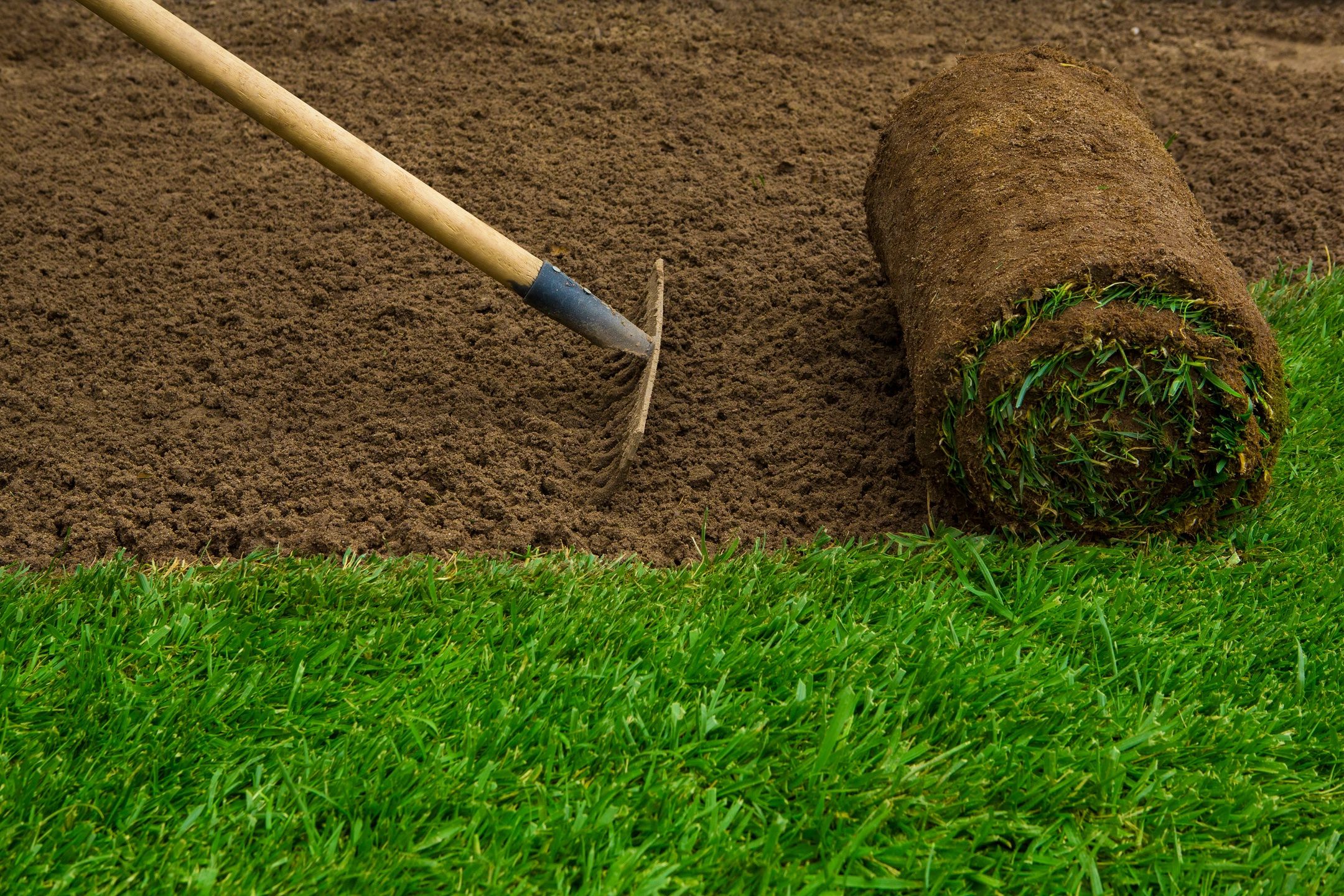SERVICES
Producing Natural Microbial Teas for the California Market

Application Services
For all orders over 100 gallons to areas within a 50-mile radius, Terra Buena will transfer microbial tea into 250-gallon USPS standard totes, deliver them to your location, and do the application. Usually, what is needed is a 3/4’ male cam-lock coupler installed in the mainline of your irrigation system.
We are currently applying microbial tea through drip irrigation and micro-sprinklers. Additionally, we can set up a float-type “battery box” injector for flood irrigation. Our plastic drums allow vegetable seedlings, grape rooting, and bare roots to be dipped and drenched before planting a vineyard or orchard. Terra Buena microbial teas can also be used for treatment on seeds for improved germination.
Field Services
Our field services are also included in each Terra Buena Microbial Tea Program. At our cost, we include a variety of third-party lab testing for the following:
- Baseline Soil Analysis – This is a standard soil test taken before any microbial tea is applied.
- Baseline “Saturated Paste” Soil Analysis – Also done before any microbial tea is applied, this test is important because it tells you how much of each nutrient is in a form that is available to the plant.
- Baseline Microbial Analysis – This test uses a soil sample to determine the size of the microbial populations that currently exist in the rhizosphere.
Many nutrients in our San Joaquin Valley soils, especially phosphorus, exist in high amounts but are not in a form that is available to the plant. Don’t be fooled by a standard soil analysis just because you have plenty of minerals and nutrients. Based on your soil analysis report, most are in forms not applicable to the plant.




Use Microbes for Your Plants and Produce
Microbes are incredibly efficient in making nutrients available to the plant, especially phosphorus, nitrogen, and potassium. Scientific literature shows that Mother Nature was designed with bacteria that were capable of supplying all nutrients to the plant.
As we say here in Terra Buena, “Feed the soil, not the plant.” Plants form a synergistic relationship with all of the microbes in their rhizosphere, and these microbes are capable of supplying the plant with what it needs when it needs it.
Frequently Asked Questions
Valley Organic Fertilizer
[email protected]
(559) 513-4076
Terra Buena “B” and “F” Microbial Formulations
Terra Buena microbial tea is a water-based bio-fertilizer, wherein beneficial microbes, mainly bacteria and fungi, and, to a lesser degree, protozoa, arthropods, ciliates, and nematodes, are extracted from a variety of organic substances and combined to create the perfect natural fertilizer. Terra Buena is an oxygen-rich (aerobic) "living solution," where all the microbes that make up the "Soil Food Web" play specialized roles in providing the specific nutrients needed for a plant to thrive.
These microbes are "extracted" from their sources by the gentle, but forceful agitation created by a high-pressure commercial air pump inside a large tank, known as a "Vortex Bio-Reactor."
The microbes that are extracted inside the Vortex Bio-Reactor are subjected to a perfect atmosphere (water temperature and an oxygen-rich environment), along with the addition of a proprietary food source and catalyst. Oxygen content in the water and, most importantly, the correct food source must be present for exponential microbial reproduction. Given the right conditions, bacteria are capable of reproducing every 20 minutes. The entire "brew" process takes approximately 24 hours.
Microbes make up the lower trophic levels, or “life levels,” of the Soil Food Web. They consist of, from smallest to largest, bacteria, fungi, protozoa, and nematodes.
Microbes are extraordinarily prolific. A single microbe reaching maturity and dividing within less than a half an hour, can, in the course of a single day, grow into 300 million or more, and, in another 24 hours, to more than the number of human beings than have ever lived.
Microbes have been feeding plants for FAR longer than humanity. Plants have had a symbiotic (mutual) relationship with the soil since prehistoric times. Science has proven that plants actually feed the soil to attract specific microbes when a specific need arises. Science has shown that microbes are capable of making nutrients available to the plant that were previously in a form that were unavailable to the plant. In fact, up to 50% of the materials created by plants through photosynthesis are fed to the soil as "exudates". In other words, plants make meals (sugars) to attract MICROBES.
Microbes are truly vital to life on earth, from the good microbes (probiotics) that exist in our digestive system to the microbes that perform so many critical functions in a "Living Soil."
Consider the forest, these trees grow to over 100 feet tall without any fertilizer. This is a direct result of microbial activity. Microbes process organic matter (humus and leaves) from the forest floor into the specific nutrients necessary for plants to grow and fight off disease and pests. This is the direct result of microbial strength, maturity, and diversity.
Microbial fertilizers are perfectly balanced organic fertilizers. Microbes allow Terra Buena to “FEED the Soil, not the PLANT,” the way Mother Nature intended.
At one time, all soils were "living soils." Unfortunately, with the advent of surplus, petroleum-based fertilizers, especially after World War II, our soils have become sterilized by repeated use of synthetic, commercial fertilizers. Because most microbes cannot survive in a petroleum-based fertilizer environment, most synthetic fertilizers destroy microbial activity. Any soil that has been under commercial fertilization practices has had its natural population of living microbes slowly and systematically destroyed. What used to take 25 to 50 lbs. of nitrogen fertilizer per acre, now requires 175 to 200 lbs. per acre to do the SAME job (with a conventional fertilizer program).
Yes, there are 2 main different types of Microbial Teas:
- Aerobic teas
Aerobic, or AAMT (Actively Aerated Microbial Tea), is the type of microbial tea that I have chosen to produce here in the San Joaquin Valley. This tea is "alive," meaning that all microbes are living, and they require oxygen to survive and reproduce. We have found that aerobic, or “living” microbial teas are superior due to their oxygen requirement. Since these beneficial microbes are aerobic in nature (there is normally sufficient oxygen in the rhizosphere, where these microbes build their neighborhoods), they are immediately capable of performing their specific functions. We have found through extensive 3rd party lab testing that "aerobic" teas are much more prolific and diverse. You will see later why diversity in microbes is so important. - Anaerobic teas
Anaerobic, or Dormant teas almost sound like an oxymoron, since we have been taught in biology that aerobic microbes are good and anaerobic microbes (facultative) like E. coli and Salmonella are not good and very dangerous in our food system. When making a dormant or anaerobic tea, the microbes go through a fermentation process to stabilize the tea. The oxygen is consumed through this process, causing the microbes to become dormant or in a state of "stasis" or inactivity. Our experience through third-party lab tests has demonstrated that when dormant or anaerobic teas are applied in agriculture, the dormant microbes sometimes remain dormant. Many even perish after prolonged shelf-life without any oxygen.

Tanimura & Antle, Spreckels, CA

Sun Pacific Farms, Bakersfield, CA
No, all aerobic teas are not created equal. Based on the diversity of the organic components used, aerobic teas can differ greatly. Our microbial recipes have many different functions. Different types of plants require different types of microbial teas:
- "Annuals," like turf and vegetables, require a more "bacterial" atmosphere, so we make our microbial tea for annuals utilizing more bacterial organic sources.
- "Permanent" crops, like grapes, almonds and citrus, like a more "fungal" atmosphere. Accordingly, we use sources that are rich in fungi to extract these wonderful creatures. Also, since fungi are slower to reproduce, we grow our own fungi cultures to add to our brew to help facilitate a normal 24-hour brew time.
Even though "annual" crops, like veggies and turf, prefer a bacterial environment, we strongly recommend using a "fungal" tea occasionally as part of the program. Once again, diversity is extremely important in microbial populations in our rhizosphere, but more importantly, fungal teas are very fungally-suppressive and can be very effective in combatting soil-borne fungal diseases like phytopthera and phythium, both of which are very prevalent in our San Joaquin Valley soils.
If you are currently under a microbial fertilization program, we strongly recommend that you periodically send a sample to a third-party laboratory to determine its microbial content and diversity. You might be surprised as to its efficacy. Terra Buena would be glad to help you facilitate the proper protocol for a sample being sent to a third-party laboratory.
We source our ingredients from all over the world. All of our products come directly from the earth and are 100% Organic. Humic acid, blu-green algae, and kelp are only a few of the catalysts we use, along with a vast array of complex carbs for a microbial food source. We never use sugar or molasses for a food source; this only creates microbes that become "sugar-junkies" and continue to crave a sugar source until it is depleted. They then perish, before they are ever allowed to do their important work in the soil.
In order to facilitate the high fungal needs of a "permanent" crop like grapes, almonds, or citrus, Terra Buena grows its own strains of fungi in controlled atmosphere growth chambers. Without doing this, it would be difficult to have a "Fungal-Dominant" tea which is the environment a permanent crop desires.
Microbial teas are obviously in a liquid form. They can be applied many ways, as a foliar spray, a "drench," or the tea can be injected right into the irrigation mainline. We recommend a minimum rate of 5 to 10 gallons per acre for each application thru drip or micro-sprinkler type irrigation. We brew 500 to 1000 gals daily, and for large orders, we prefer to do the application free of charge.
Yes, all of our microbial teas utilize "OMRI," or State of California Certified Organic component
Yes. We have many growers using our microbial teas on large commercial/conventional acreage and we also have many golf courses using this microbial tea on their turf. If you are using conventional fertilizers, we ask that you wait at least 7 days between the use of microbial fertilizers and conventional fertilizers.
Absolutely. We have proprietary fungal and bacterial recipes, but we also have customers that want specific biostimulants, or certain nutrients, like "Sea Crop" added to the brew. Sea Crop is a very powerful ocean mineral concentrate, that contains over 90 natural source trace minerals and active organic substances.
All of our microbial teas contain:
- Photosynthetic bacteria: These bacteria supply energy from light and are also capable of fixing nitrogen and carbon at the foliar level to function within the root zone. Photosynthetic bacteria also assist in the conversion of organic carbon for improved plant growth
- Heterotrophic bacteria: This is where "diversity" of microbes plays a major role. Heterotrophic bacteria improve critical chemical reactions (i.e. Calvin-Benson photosynthetic reaction, nitrogen fixation, carbon cycle, phosphate solubilization and potassium solubilization), and without these specific bacteria strains, these biochemical reactions would not exist on earth. They also restore and speed up the development of critical soil biology within the rhizosphere, which is the aerobic area approximately 10 to 12 inches from the soil surface where the majority of the important roots exist. The rhizosphere is that narrow region of soil around the root tip where plants encourage the growth of beneficial bacteria by the secretion of sugars. Much of the "nutrient cycling" and "disease suppression" occurs within the bacterial populations living in this rhizosphere. Heterotrophic bacteria are also capable of breaking down toxic chemicals, such as pesticides. Most importantly, these bacteria speed the biological breakdown of organic matter to provide the beneficial nutrients to plants.
- Mycorrhizal fungi: These specialized filamentous soil fungi form a symbiotic relationship with the plant's roots to provide crucial nutrients at critical times. They attach themselves to the existing plant roots and provide a more extensive matrix for accessing nutrients and moisture. Science has also shown that they assist the plant in developing a much larger and improved root system, increasing the plant's ability to absorb necessary nutrients. Mycorrhizal fungi are specialized fungi that are also very important since they have the potential to greatly improve soil porosity in some of the heavier San Joaquin Valley soils. Mycorrhizal fungi have the potential to be a “game-changer” in some of these heavier problematic SJ Valley soils.
- Bacillus Bacteria: A very large and diverse species. They are known to produce natural auxins and hormones and other substances to promote plant vigor. Some of the Bacillus species are also capable of breaking down complex organics to READILY AVAILABLE forms of plant nutrients.
- Microbial teas are used to improve seed germination. Science has shown that they can promote earlier seed germination and faster growth.
- Microbial teas are critically important in restoring soil biology where fumigants or nematicides have removed or sterilized all living soil microbes. We strongly recommend a microbial tea "drench" on the bare roots BEFORE planting, along with the application of a dose of microbial tea approximately 4 to 6 weeks AFTER planting to encourage microbial diversity and establish the necessary colonies of microbes in the rhizosphere.
- Improved "BRIX" levels in fruits and vegetables. BRIX level is the measurement of carbohydrates or sugars in a plant or fruit. A higher BRIX level indicates a stronger plant and produce with a higher nutritive value. A higher BRIX level is also an indicator of a more robust plant, and robust plants are more resistant to insects and disease.
- There have been many university studies (Purdue and Texas A&M, to name just a few) that have proven that commercial or synthetic fertilizers have DRASTICALLY reduced the nutritional value in our fruits and vegetables. This is not the case with the use of microbial teas. If used properly, microbial teas have the potential to increase yield and drastically improve nutritional content.
Microbial teas can be used every day on every watering if desired. It is impossible to overuse microbial teas. Unlike synthetic fertilizers, they do not burn or produce any phytotoxicity.
Generally, with our programs, we recommend microbial teas be used on a monthly basis.
Also included with each Terra Buena tea program, at our cost, we include 3rd party testing for:
- Baseline Soil Analysis
- Baseline Saturated Paste Soil Analysis: This determines nutrients that are in a form that is IMMEDIATELY available to a plant. Many nutrients in our San Joaquin Valley soils, especially Phosphorus, exist in our soils, but are in a form NOT available to the plant.
- Baseline Microbial Analysis. This determines the size of the current microbial populations in the rhizosphere.Six months later, or "post-harvest," all three tests are performed again (at our cost) by third party laboratories to show progress and exponential growth of microbes, along with any increase of available nutrients that the microbes have made available, as a potential energy source for the plant.
- Microbes increase Soil Organic Matter: Soil organic matter (SOG) is a storehouse for many plant nutrients.
- Every 1% increase in SOM results in a 1,000 lb increase in nitrogen and a 100 lb. increase in each of phosphate, potassium, and sulfur.
- Every 1% increase in SOM results in a 2-3 fold increase in the soil’s water-retention capacity.
“Producing more food with fewer resources may seem too good to be true, but the world’s farmers have trillions of potential partners that can help achieve that ambitious goal. Those partners are microbes.” (A report from the American Academy of Microbiology, entitled “How Microbes Can Feed the World”, Dec. 2012).
Microbes make bigger and healthier roots; bigger and healthier roots equal bigger fruits!
Any questions, please feel free to contact us.

